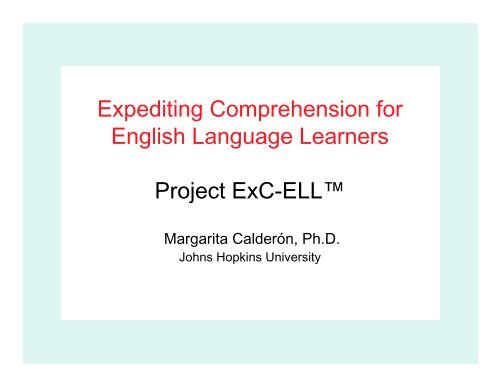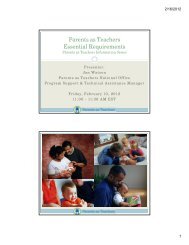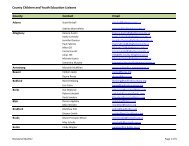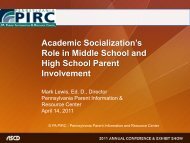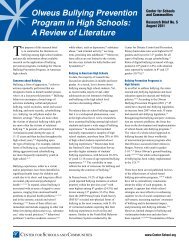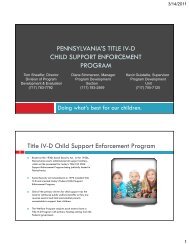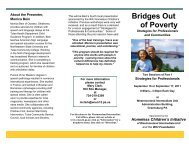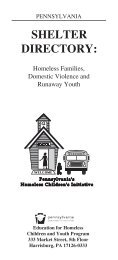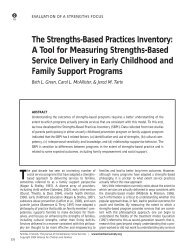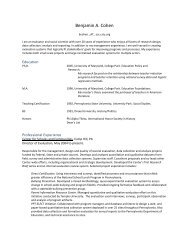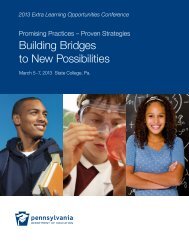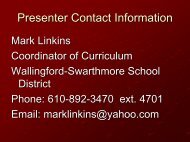Expediting Comprehension for English Language Learners Project ...
Expediting Comprehension for English Language Learners Project ...
Expediting Comprehension for English Language Learners Project ...
Create successful ePaper yourself
Turn your PDF publications into a flip-book with our unique Google optimized e-Paper software.
<strong>Expediting</strong> <strong>Comprehension</strong> <strong>for</strong><strong>English</strong> <strong>Language</strong> <strong>Learners</strong><strong>Project</strong> ExC-ELLMargarita Calderón, Ph.D.Johns Hopkins University
Agenda• Intro to ExC-ELL research• Vocabulary Instruction• Reading• Writing• Consolidating content, language andliteracy• Teachers’ TLCMargarita Calderon/JHU 2
The New YorkCarnegieCorporation Goal<strong>for</strong> ExC-ELL(2003-2008) is to:Collaboratively develop, implement, and refinea staff development program and instructionaldesign <strong>for</strong> middle and high school teachers of<strong>English</strong>, science, and social studies who have<strong>English</strong>-language learners (ELLs) in theirclassrooms.Margarita Calderon/JHU 3
Target PopulationTeachers with diverse groups of students:• Relatively recent newcomers in middle and highschools with or without schooling.• ELLs who have been in US schools <strong>for</strong> longerperiods of time but are not making progresstoward meeting high academic standards,reading below 4th grade level.• <strong>English</strong>-only students in these classrooms.Margarita Calderon/JHU 4
RIGOR - Reading Instructional Goals <strong>for</strong> OlderReaders LEVELS 1, 2, AND 3R3SOCIALSTUDIESR3LANGUAGEARTSRIGOR 1& 2BeginningliteracyR3SCIENCER3MATHMargarita Calderon/JHU 5
RIGOR - READING INSTRUCTIONAL GOALSFOR OLDER READERS LEVELS 1, 2, AND 3FoundationIn Research& TheoryText-level<strong>Comprehension</strong>StrategiesRIGOR1, 2, 3ExC-ELLWord-levelInstructionalStrategiesReading-WritingConnectionsAssessmentsMargarita Calderon/JHU 6
The Lesson Structure <strong>for</strong> RIGOR ® Levels1 and 2 -- Pre-Literacy Skills.1. Letter sound activities (Say it; Find it; Use it).2. Words from Text (Say it; Use it; Spell it;Define it; Read it).3. Meaning of Words from Text (Own it).4. Strategic Reading with Decodable Text (FollowAlong; Read it; Say it; Think it; Aha!)..5. Prosody/Fluency (Read along; Feel it).Margarita Calderon/JHU 7
The Lesson Structure <strong>for</strong> RIGOR ®Levels 1 and 26. Partner Reading (Partner reading; Partnersummaries).7. Partners or Team Cognitive Maps and Retell(Map it; Master it).8. Random Calls (Prove it).9. Writing from Reading (Write about it).10. Assessments: Read it; Spell it; Define it;Match it; Write with it).Margarita Calderon/JHU 8
Focus <strong>for</strong> Content TeachersStrategies to develop students’‣ word knowledge‣ basic reading skills (fluency)‣ comprehension of classroom texts‣ discussion skills‣ grammatical knowledge‣ spelling‣ writing skillsMargarita Calderon/JHU 9
Next Steps The Carnegie Phase 2 to test ExC-ELL Observation Protocol as atechnology/handheld device ExC-ELL randomized scientificstudy in New York City middleand high schools.Margarita Calderon/JHU 10
Logitech Digital PenPen DockingStation:To store recorded dataon the computerCamera:To record data as theuser writes on thedigital paperInk Pen:To write observationson the digital paper
Margarita Calderon/JHU 12
Observation Detail ReportSCHOOL: SCHOOL A GRADE: 7 OBSERVER: MARGARITA CALDERÓNTEACHER: MS. JONES COURSE TITLE: BIOLOGY OBSERVATION TYPE: CLASSROOM OBSLENGTH OF PERIOD: 45 MIN.LANGUAGE: ENG, SPACOMPONENT: VOCABULARYTIME SPENT: 12 MINTime on ComponentsINDICATOR AVG SCORE: 2.5STUDENT APPLICATIONSTUDENTSTIER 1#1-ELL #2-NON #3-ELL #4-NONWORD1 2 3 1 4WORD2 2 2 1 3WORD3 1 2 3 2TOTAL 5 7 5 9TIER 2WORD4 etc.WORD5WORD6WORD7WORD8Vocab Oracy Reading Writing ContextTOTALTIER 3WORD9WORD10TOTALCOMPONENT: ORACY TIME SPENT: 5 MININDICATOR AVG SCORESTUDENT APPLICATIONCOMPONENT: READING TIME SPENT: 10 MININDICATOR AVG SCORESTUDENT APPLICATION[etc., <strong>for</strong> WRITING, CONTEXT]Margarita Calderon/JHU 13
Teacher Profile Summary ReportSCHOOL: SCHOOL A GRADE: 7 # OBSERVATIONS: 3TEACHER: MS. JONES COURSE TITLE: EARTH SCIAVG COMPONENT SCORES and AVG TIME SPENTOBS TYPE DATE VOCAB ORACY READ WRITE CONTEXT ASSESSCLASSROOM 9/16/06 2.5 11 3.5 10 3.0 12 2.5 12 3.0 1 3.5 N/AOBSminmin min min minCLASSROOM 9/30/06 3.0 13 3.5 11 3.5 9 3.0 13 3.0 1 3.5 N/AOBSminmin min min minCLASSROOMOBS10/15/06 3.2 12min3.5 11min3.0 16min3.2 14min2.5 1min3.0 N/A43.532.521.510.509/16/2006 9/23/2006 9/30/2006 10/7/2006 10/14/2006Vocab Oracy Read Write Context AssessMargarita Calderon/JHU 14
ExC-ELL Observation Protocol®Data Collection & Reports.• Logitech Digital Pena pen that records the data as it is written down ondigital paper• ExC-ELL Observation Protocol ® Digital Form• Reports9-page digital paper <strong>for</strong>m to note observations in theareas of Vocabulary, Oracy, Reading, Writing,Classroom Context and Assessment6 types of reports can be created from the recordeddata:• Observation Summary Report• Observation Detail Report• Teacher Profile Summary Report• Component Implementation Summary Report• Vocabulary Usage Report• Student Application Summary Report
EOP is used <strong>for</strong>:By teachers <strong>for</strong> designing / developing their lessons.By teachers <strong>for</strong> self-reflection.By teachers <strong>for</strong> observing and documenting studentper<strong>for</strong>mance.By principals and supervisors <strong>for</strong> observing andcoaching teachers.By coaches to give concrete feedback to teachers.By researchers to collect data on teacher and studentgrowth and quality of implementation.Margarita Calderon/JHU 16
5-Day Institute• All lesson components• Demonstrations/modeling• Practice of strategies• Research-base/rationale• Reflection and discussions• Development of contentlessonsMargarita Calderon/JHU 17
InstituteFollow-up• Two-day refresher workshops, ongoingfollow-up expert coaching and collegialactivities in Teachers LearningCommunities (TLCs).• Trainers observe each teacher four timesa year to collect implementation data andcoach/help teachers.• Site coordinators, coaches, andadministrators are trained to support,observe/coach each teacher frequently.Margarita Calderon/JHU 18
Content Area Literacy ApproachesWithout reading instruction from content areateachers:• SURFACE COMPREHENSION--Literalcomprehension; students read on their own andanswer questions; questions are low-level.With reading instruction from content area teachers:• DEEP COMPREHENSION --Criticalcomprehension; students learn new vocabularycontinuously; associate new readings with priorknowledge; add new knowledge, discuss ideas,interpret facts and in<strong>for</strong>mation, and apply criticalthinking skills to text.Margarita Calderon/JHU 19
Teachers of ELLs must balance comprehensible inputwith rich challenging vocabulary!ESLSHELTEREDINSTRUCTIONCOMPREHENSIBLEINPUTCONTENTRICHVOCABULARYAND READING!Margarita Calderon/JHU 20
1. Implicit practices:• Encouraging teacher-student talk.• Silent reading and discussions.2. Explicit practices:• Word learning is the direct focus of theactivity.• Students and teachers are aware of this focus(semantic awareness).• Takes place in didactic-interactional bookreading, having vocabulary explicit targets.Margarita Calderon/JHU 21
Teaching Vocabulary / ConceptsWhy breadth and depth of vocabulary?• Vocabulary knowledge correlates withcomprehension.• <strong>Comprehension</strong> depends on knowingbetween 90% and 95% of the words in atext.• To overcome the vocabulary disadvantage,we need to teach vocabulary explicitly on adaily basis.• A high achieving 12th-grader has learnedsome 15 words a day, over 5000 words ayear.Margarita Calderon/JHU 22
Put Your Heads Together3 Key Concepts So Far:1.IMPLICATIONS <strong>for</strong> ourtext books and instruction:2.3.Margarita Calderon/JHU 23
STEP 1SELECT VOCABULARY TO PRE-TEACH BEFORE PRESENTINGCONTENT, TEACHER READ ALOUD,OR STUDENT READING OF ANYTEXT.STEP 2TEACH VOCABULARY USING 7STEPS.Margarita Calderon/JHU 24
Vocabulary Tiers <strong>for</strong> ELLsTier 1 Tier 2 Tier 3Simple More Content WordsWordsSophisticatedrun sprinted <strong>for</strong>eshadow (literature)fell stumbled monarchy (history)mad rage vacuole (sciences)good firmly factor (math)
Tier 2 words can also includepolysemous words• ring• table• trunk• prime• round• araña• hoja• botón• bote• llamaMargarita Calderon/JHU 26
Types of WordsTier 1doghousefindnicegoodrunTier 2canineabodesearch/findtrunkfabuloussprintTier 3predatorhabitatinvestigatepolysemousbeneficial42 meaningsof run!Margarita Calderon/JHU 27
VOCABULARY TIERS (TEARS?) FOR ELLsPolysemous words -- How many content applications?PRIMEPOWERRADICALIMAGINARYLEGRIGHTTREECELLROUNDMargarita Calderon/JHU 28
• Sum -- sumaCognatesTier 3• Complement -- complementar• Perpendicular -- perpendicular• Factor -- factor• Equation -- ecuación• Mathematics -- matemáticas• Algebra -- algebraMargarita Calderon/JHU 29
FalseCognates• Library ≠ libreria (bookstore)• Exit ≠ éxito (success)• Attend a meeting ≠ atender …(asistir a una junta)• May I assist you?(¿Le puedo atender?)Margarita Calderon/JHU 30
SELECTING WORDS TOTEACHActivity -- Read the Jumanji text:1. Select 2 Tier 1 words2. Select 2 Tier 2 words3. Select 2 Tier 3 wordsthat you would pre-teach so that ELLscan understand the story.Margarita Calderon/JHU 31
J U M A N J IAdapted from a storyBy CHRIS VAN ALLSBURG“Now remember,” Mother said, “your father and Iare bringing guests by after the opera, so please keepthe house neat.”“Quite so,” added Father, tucking his scarf inside hiscoat.Mother then knelt and kissed both children goodbye.When the front door closed, Judy and Peter giggledwith delight. They took all the toys out of their toychest and made a terrible mess. But their laughterslowly turned to silence till finally Peter slouched intoa chair.“You know what?” he said. “I’m really bored.”
PRE-TEACHING VOCABULARY1. Teacher says the word.2. Asks students to repeat the word 3 times.3. Teacher states the word in context from thetext.4. Teacher provides the dictionarydefinition(s).5. Explains meaning with student-friendlydefinitions.6. Engages students in activities to developword/concept knowledge.7. Highlight grammar, spelling, polysemy, etc.Margarita Calderon/JHU 33
TEACHING CONCEPTS/VOCABULARY1. Teacher says the word.2. Teacher states the word incontext from the text.3. Teacher provides the dictionarydefinition(s).4. Explains meaning with studentfriendlydefinitions.5. Asks students to repeat theword 3 times.6. Engages students in activitiesto develop word/conceptknowledge.7. Students say the word again.• Weather can have a bigeffect on your life.• Say effect 3 times.• The result or consequenceof something.• Influence, or the power tomake something happen.• Two cups of coffee in themorning have a big effecton me -- I can’t sleep atnight!• What has had a big effecton your life recently?TTYPMargarita Calderon/JHU 34
TEACHING VOCABULARY1. Teacher selects the word andsentence from the text.2. Provides dictionarydefinition.3. Explains meaning withstudent-friendly definitions.4. Provides examples incontexts other than the onein the text.5. Asks students to repeat theword 3 times.6. Engages students inactivities to develop wordknowledge.7. Students say the word again.• Over the course of hundredsof years, weather trendsaffect life on Earth in moredramatic ways.• [verb] To influence orchange someone orsomething.• Jason’s accident affectedhim badly.• [adjective] False andunnatural.• Jena’s affected voice makesher sound like she’s acting.• Use the word as a verb andas an adjective.Margarita Calderon/JHU 35
TEACHING CONCEPTS/VOCABULARY1. Teacher selects theword/concept from the text.2. Gives dictionary definition tothe students.3. Explains meaning withstudent-friendly definitionsor visuals.4. Provides examples incontexts other than the onein the text.5. Asks students to repeat theword 3 times.6. Engages students inactivities to developword/concept knowledge.7. Students say the word again.• Antarctica is a very coldcontinent.• Define the word continent.Point to Antarctica on theglobe and indicate it is acontinent.• Name and point to the othercontinents.• Ask students to say the word 3times.• Ask students to show you thecontinent they are currently in,as which continent theirrelatives have come from.• Students say the word again.Margarita Calderon/JHU 36
For reviewing vocabularyQuestions, Reasons, Examples• If you are walking in a darkroom, you need to do itcautiously. Why? What aresome other things that need tobe done cautiously?• Which of these things might beextraordinary? Why or whynot?- a shirt that was com<strong>for</strong>table, ora shirt that washed itself.- a plane landing on the schoolyard, or a plane landing at theairport?- a person who has a librarycard or a person who has readall the books in the library?Making Choices• If any of the things I say mightmake someone look radiant,say “You look radiant!” If not,don’t say anything.- winning a million dollars- getting a root canal- getting a hug from my favoritemovie star- a day at the beach- cleaning your room.• Applaud if you’d like to bedescribed by the word: frank,awesome, impish, vain,stubborn, stern. And, tell whyyou feel that way.Margarita Calderon/JHU 37
Engagement with TextStep 3: Teacher Read AloudWhy Teacher Read Alouds in Secondary?Margarita Calderon/JHU 38
From one day to the next, weather can have abig effect on your life. When it rains, you haveto stay indoors or carry an umbrella. When it'scold, you have to bundle up.Over the course of hundreds, thousands, andmillions of years, weather trends affect life onEarth in more dramatic ways. Ice ages or longdroughts, <strong>for</strong> example, can wipe out certaintypes of plants and animals. Although manyspecies manage to survive such extreme,long-term climate shifts, their living conditionsalso change.Does a change in the weather signalglobal climate change?National Oceanic and AtmosphericAdministrationA Change in ClimatebyEmily SohnThere's lots of evidence of drastic changes in climateoccurring in the distant past. Earth today may again be inthe midst of such a climate change. In the last 100 years,studies show, global temperatures have risen an averageof 0.6 degrees C.That might not sound so bad. After all, what differencedoes half a degree make?A growing number of studies suggest, however, that suchan increase could have a big impact on life.Biologists and ecologists are discovering, often byaccident, that climate change is <strong>for</strong>cing some plants andanimals into new habitats. Others are becoming extinct.Sometimes, scientists show up at a site they've studied <strong>for</strong>years, only to discover that the organisms they've beentracking are no longer there. What's more, it now looks likethis redistribution of life on Earth is sometimes happeningat an alarmingly fast pace."These little pieces of in<strong>for</strong>mation are all warning signs thatstuff is going on," says Erik Beever. He's a researchecologist with the United States Geological Survey inCorvallis, Ore. "Our world is changing more rapidly than wehave observed in the recent past," he says.
From one day to the next, weather can have abig effect on your life. When it rains, you haveto stay indoors or carry an umbrella. When it'scold, you have to bundle up.Over the course of hundreds, thousands, andmillions of years, weather trends affect life onEarth in more dramatic (big, dramático) ways.Ice ages or long droughts, <strong>for</strong> example, canwipe out certain types of plants and animals.Although many species manage to survivesuch extreme, long-term climate shifts(changes), their living conditionsalso change.Margarita Calderon/JHU 40
There's lots of evidence of drastic (drásticos,dramatic, big) changes in climate occurring(ocurriendo) in the distant (distante) past. Earthtoday may again be in the midst of such aclimate change. In the last 100 years, studiesshow, global temperatures have risen anaverage of 0.6 degrees C. (Celsius orcentigrade / centigrado?).A growing number of studies suggest(sugieren), however, that such an increase(more in number) could have a big impact onlife.Margarita Calderon/JHU 41
Tree lineOne place to look <strong>for</strong> changes in plant and animallife that may be caused by a climate shift is in themountains.As the globe warms up, mountaintops get warmer,too. Trees start growing at higher altitudes thanbe<strong>for</strong>e. The tree line shifts upward.In the Alps, a mountain range in Europe, recordsfrom the last 80 to 100 years show that plants havebeen working their way upward at a rate of about 4meters every decade. Researchers from theUniversity of Vienna found this trend in two-thirds ofthe sites they checked."When I first saw the results," Beever says, "I had a reallyhard time believing it because it's just too fast."Beever's analysis of the data suggests that globalwarming is mainly responsible <strong>for</strong> the shift. Studies inmountain ranges from New Zealand to Spain revealsimilar trends.Global WarmingWhat's causing today's increased temperatures?Many scientists say that human activities, such as burningcoal, oil, and other fossil fuels, are largely to blame. Theseactivities release heat-trapping gases, such as carbondioxide, into the atmosphere. The more these gasesaccumulate in the atmosphere, the hotter things get onEarth.An Englemansprucetree.Rick Wallace,UnitedStatesForestServiceIn one recent study in Nevada, Beever discovered that atype of tree called the Engleman spruce had moved itshabitat upslope a dramatic 650 feet in just 9 years. "Thesite at the lowest elevation went from 41 individuals toBurning fossil fuels produces carbon dioxide.just six," he says. At higher elevations, numbersU.S. Environmental Protection Agencyincreased.Margarita Calderon/JHU 42
affectdroughteffecthabitatimpact
Step 4 - Partner Reading The teacher reads and modelsstrategies. Partner A reads the first sentence. Partner B helps. Partner B reads the next sentence.Partner A helps. Partners continue until they finishreading the entire assigned section.Margarita Calderon/JHU 44
Step 5 -DebriefingWhole class debriefing• Students report on words and phrases theydidn’t understand; listed on their post-itnotes.• Clarification of unknown words and phrases.• Students report on gist of paragraph.• Clarification of overall meaning of theparagraph (initially; then larger chunks asappropriate).Margarita Calderon/JHU 45
Step 6 - Consolidation of Content,<strong>Language</strong> and Literacy‣ Whole-class concept / semantic maps‣ Content Retell using new vocabulary‣ Silent reading‣ Team discussions / open-ended questions‣ Work with multiple meaning words,affixes, spelling, pronunciation, fluency.‣ Content-Related WritingMargarita Calderon/JHU 46
THINKINGPROCESSAPPLYING BLOOM’S TAXONOMY OFCOGNITIVE PROCESS - 5USEFULVERBSSAMPLEQUESTION STEMSPOTENTIAL ACTIVITIESAND PRODUCTSSYNTHESISCreateInventComposePredictPlanConstructDesignImagineImproveProposeDeviseFormulateCan you design a…to…?What is a possible solutionto…?What would happen if…?If you had access to allresources, how would youdeal with…How would you devise yourown way to…?How many ways can you…?Can you create new andunusual uses <strong>for</strong>…?Can you develop a proposalwhich would…?How would you compose asong about…?Can you write a new recipe<strong>for</strong> a tasty dish?• Invent a machine to do aspecific task.• Design a building.• Create a new product. Giveit a name and plan amarketing campaign.• Write about your feelingsin relation to…• Write a TV show, playpuppet show, role play,song, or pantomime• Design a record, book, ormagazine cover <strong>for</strong>…• Devise a way to…• Create a language code.• Sell an idea to a billionaire.• Compose a rhythm or putnew words to a knowmelody.Margarita Calderon/JHU 47
Numbered Heads Together• Number off in your teamfrom 1 to 4• Listen to the question.• Put your heads together andfind the answer.• Make sure everyone in yourteam knows the answer.• Be prepared to answer whenyour number is called.Margarita Calderon/JHU 48
Descriptive Narrative Persuasive Poetry Screen play Short stories Mystery novel Marketing plan Chronology Technicalmanuals History textbooks Math books Science books Web sitesMargarita Calderon/JHU 49
Step 8 - AssessmentThe purpose of authentic assessment is to1. Focus on continuous studentper<strong>for</strong>mance (authentic task).2. Develop learner reflection.3. Address the learning needs of thereal world.4. Identify areas <strong>for</strong> instructionalimprovement.Margarita Calderon/JHU 50
Step 9 - TLCIn Teachers Learning Communities(TLCs) where they can collaborativelyand profoundly examine, question,develop, experiment, implement,evaluate, and create change.Margarita Calderon/JHU 47Margarita Calderon/JHU 51
Time Devoted to TLCs and Implementation of ReadingComponentsSTUDENT IMPROVEMENT IN READINGLowMedium HighMargarita Calderon/JHU 52
Step 10 -- Teacher Accomplishmentsin Teachers Learning CommunitiesTeachers can:Examine student per<strong>for</strong>mance data in thevarious content areas; literature, socialstudies, mathematics, or science.Analyze student progress against thecontent and per<strong>for</strong>mance standards in atimely manner.Identify student strengths and needs.Margarita Calderon/JHU 53
THANK YOU!MECALDE@AOL.COMMargarita Calderon/JHU 54


